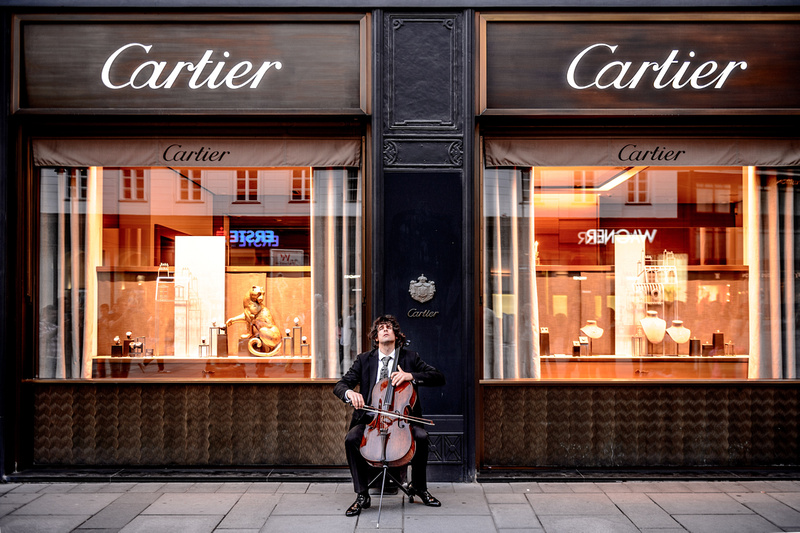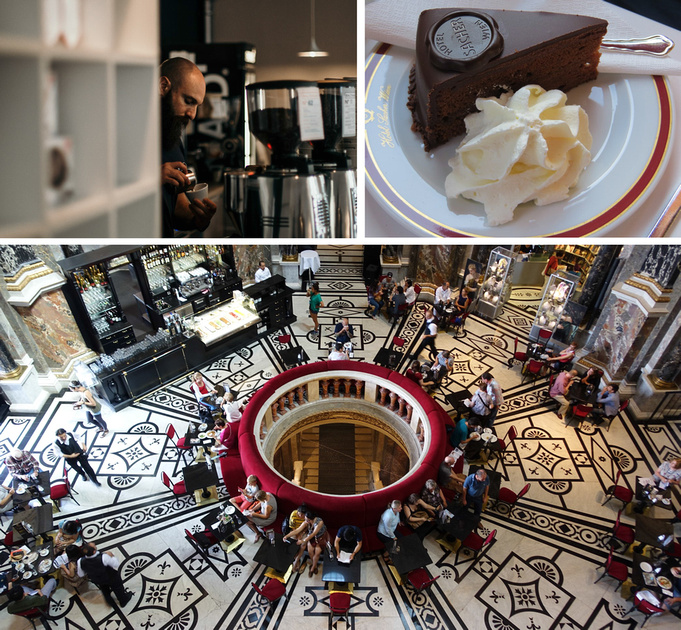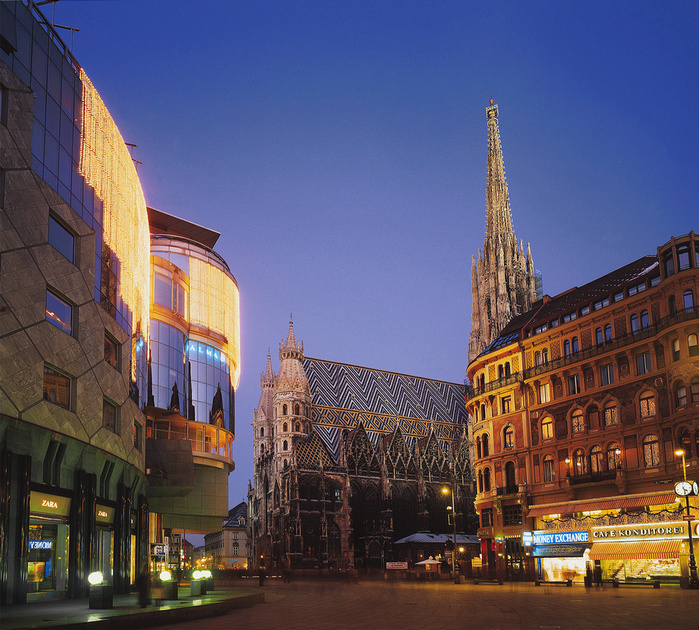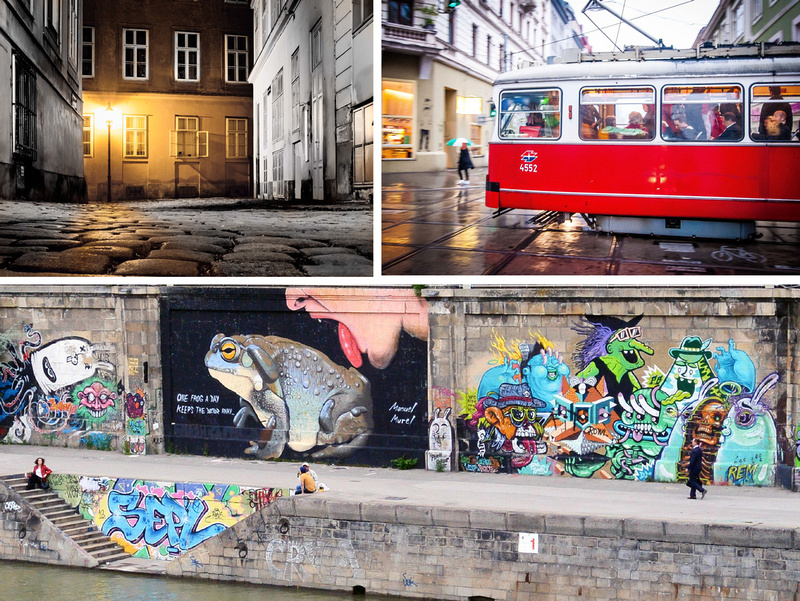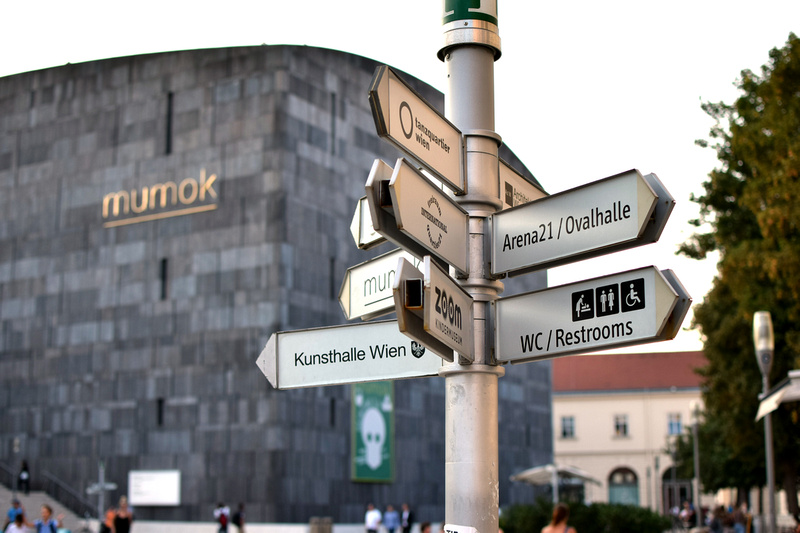VIENNA'S NEW GROOVE: Timing is everything as this former imperial capital reclaims its cultural edge
(Above: A street musician performs Beethoven's Cello Sonata No. 3 in downtown Vienna.)
VIENNA — It was Tuesday date-night at the Vienna Museum of Applied Arts, or MAK, and the seduction was underway. A saxophonist in a corner of the lobby was diving deep inside his bebop groove that was accompanying the silent film short playing on the large monitor overhead, as a college-aged trio of modern-dance artists performed for a gathering crowd.
A sucker for living art, I fell easily under its spell.
Next evening a trio of classical musicians performed a concert of avant-garde music, which I almost comprehended, at Reaktor, a dilapidated, turn-of-the-20th-century ballroom reborn as a multidisciplinary stage for cutting-edge art, music, film, literature and dance. During musical interludes I half-expected to hear a frog shower of hipsters cooing in ecstasy. But then I remembered. I was in Vienna.
Little compared, though, to the futuristic creation by the late Iraqi-born British architect Zaha Hadid, who shattered glass ceilings (no pun intended) to become the first woman to win her profession's acclaimed Pritzker Prize. To gaze at night at Hadid's Vienna University of Economics is to better understand what Architectural Digest described as her "explosion of fearless, impolite and aggressive talent."
(Above: Pritzker Prize-winning architect Zaha Hadid's Vienna University of Economics. Austrian Tourism photo/Volker Preusser)
These experiences left me feeling young and invigorated. And keenly cognizant that I was not only in Europe but in one of the world's truly international, culture-defining cities. Equally important, they were a far cry from a city occasionally (and unfairly) perceived as too content to rest on its laurels. Specifically its mélange of first-in-class Baroque and Rococo palaces, as well as a musical heritage that boasts a handful of Western civilization's most ballyhooed classical composers.
The retired Australian couple I met the day before during the four-hour train from Prague to Vienna nodded in agreement when the subject came up. The amicable white-haired husband unfolded a map and pointed to the well-trod tourist attractions that helped make this bastion of waltzes the bee’s knees of Europe during the 18th and 19th centuries.
“Palace, palace, palace … cathedral, cathedral, cathedral,” he said rolling his eyes.
Considering the only palace in Australia is the Palace Cinema in Melbourne, a more insightful comment might have opined how Vienna — then and now — personifies the truly grand European capital. To feel this viscerally I had only to stand in the late-afternoon shadows of majestic Schönbrunn Palace. The Hapsburg family’s 640-year rule over half of Europe bit the dust in 1918 at the end of World War I. They left behind this 1,440-room Rococo refuge as Allied Powers began dismantling what remained of Europe’s biggest royal houses (plus the Ottoman Empire). The dual monarchy better known as Austro-Hungarian Empire, which had fought alongside Germany, was julienned like a carrot. Auf wiedersehen.
Ditto when gazing up at the imposing 13th-century Hofburg Winter Palace, formerly the Hapsburgs’ principal digs and today the workplace of the President of Austria. It was here from the palace's sweeping central bay that Austrian-born Adolph Hitler gave his conciliatory speech in 1938 in front of cheering Viennese crowds after Germany invaded and proclaimed its annexation of Austria.
Far gentler times are reflected in the eye-catching art nouveau facades that flatter the pleasant, upscale shopping districts of Kohlmart, Graben and Rotentum. Called Succession or jugenstihl (German for “young style”) in Austria, art nouveau decorates this carefully manicured cityscape with dignity, purpose and curvilinear beauty.
(Above: The Karlsplatz U-Bahn station was designed by Otto Wagner, the pioneering architect of Vienna's art nouveau era.)
II. 'NUDING UP' On a human level Vienna offers a delightfully quixotic, mixed bag of observations. A surprising number of men, for example, sport '70s-style porn-staches, which might be some weird Freudian compensation for the fact that many Austrian males prefer to pee sitting down. Conversely, nowhere did I spy any adult female wearing ironically oversized sunglasses. Apparently grown-up Viennese women, unlike those in big-city America, do not dress as though they're starring in a romantic comedy for teens.
Five minutes spent inside any nightclub is sufficient proof that no one in this city can dance.
And if you think Vienna makes your butt look big, you're probably right. Fitness for Austrians, as a rule, begins in childhood — not with gym memberships but rather family treks on the national stair climber better known as the Alps. Perhaps this is why no one blinks an eye when "nuding up," local parlance for when people of all ages, including families and grandparents, sunbathe au naturel in public parks.
Guide/translator: "Do you wish for a little nuding up after lunch?" Me: "Er, no."
High culture is literally everywhere — especially if you're keen on stepping back in time and stepping up in class. Bucket-list tourists eager to sample this city’s centuries-old devotion to artistic precision, for instance, typically flock like pigeons to witness the mad skills of the Vienna Boys’ Choir and the Spanish Riding School’s prancing Lipizzaners.
Day or night my preference for unpracticed hashtag truth instead found me leaning on this city’s legendary coffeehouses. Namely because it's near impossible to spend time in these lively, atmospheric venues without bumping into ghosts of Vienna’s — and, indeed, some of the world’s — most famous artists and intellectuals.
One evening at Café Frauenhuber, while enjoying artisanal cocktails and the Viennese-born chocolate heaven known as Sachertorte, it was fun imagining this mannered establishment as Mozart and Beethoven's nightspot of choice for performing new compositions in front of a live audience. No one would ever mistake this buzzing java den for its American counterpart — and not just because Vienna is among the last European cities that still permits smoking indoors. First, the waiters all wear tuxedos, a long-time tradition and required by Austrian law. Second, no one sits quietly alone in the corner with his nose buried in a tablet or laptop.
“A coffeehouse in Vienna — it’s life,” says Diane Naar, an English-born writer who has called this city home for nearly 40 years. “It’s where Viennese come for dinner, meet friends, have intellectual conversations. Look around — people are actually talking to one another; people who have only just met while sharing a table.”
(Clockwise from top-left: a coffeehouse worker prepares a cup of java; the near-sacred Sachertorte served alongside a dollop of crème fraiche at the Hotel Sacher; the buzz of a Viennese coffeehouse is palpably different than its counterparts in Europe and in the United States.)
A hunt for far more recent phantoms found us chowing down on Germknödel (fluffy, poppy-seed dumplings filled with warmed plum jam) at Café Central, whose turn-of-the-20th-century, guest-list notables runs the gamut from Sigmund Freud and Gustav Klimt to Vladimir Lenin and Leon Trotsky. Little in this world beats stuffing your piehole with sweets while remembering that workers control the means of production.
When it comes to the main course, though, Austrian fare borrows heavily from its Slavic neighbors and former imperial territories including Hungary and the Czech Republic: cheese-stuffed bratwurst, leberkase (meatloaf), potato dumplings, curd cheese crepes and weiner schnitzel. This discovery was made following an evening bus ride to Grinzing, located inside Vienna, to a charming heurigen (pronounced HOY-rig-en), a cozy, rustic wine tavern where owners are allowed by law to sell young wines produced in their own vineyards. Despite the festive vibe of live oompah music, some local wines and cuisine may not surpass everyone’s threshold for excellence.
All of which is why a refreshing afternoon repast of freshly baked olive bread and creamy gazpacho at a local Spanish restaurant seemed heaven sent. Adding to the Iberian gastronomy was the location of the restaurant itself: tucked on the third-floor, wrap-around balcony of the postmodern, mirror-and-stone commercial building called Haas Haus. Here the best view in the house — er, haus — was from any balcony table of the 800-year-old St. Stephan’s Cathedral, or Stephansdom as it’s affectionately dubbed by locals. Topping off the Gothic-on-steroids masterwork is a sky-piercing, 450-foot-tall spire visible throughout the city, which explains why this beloved 12th-century landmark is considered the spiritual heart of Vienna.
Says Naar, “Anyone who wants to lay it on thick has their wedding there.”
(Above: The postmodern, mirror-and-stone commercial building known as Haas Haus, left, designed by star architect Hans Hollein, sits catty-corner from the 12th-century St. Stephan's Cathedral, or Stephansdom, and its landmark 450-foot-tall spire. Vienna Tourism photo/Georg Popp.)
Culturally sophisticated with deeply ingrained artistic values, Vienna is like the college crush I never had the nerve to talk to because she was clearly out of my league. Yet at night this irretrievably romantic and beautifully illuminated metropolis inspired me to stop thinking of what could go wrong and instead think of what could go right. Almost made me want to drunk-dial her 40 years after the fact. Almost.
To be sure this gateway to Eastern Europe never fails to trigger a favorite travel fantasy: prowling its streetlamp-lit backstreets in a Burberry trench coat, speaking a dozen languages to a dozen dangerous women. Adding to this fancy are fleeting scenes from two favorite movies that were shot here: the 1949 British film noir classic, "The Third Man" (yes, you can still ride the Riesenrad, or giant Ferris wheel); and the oddly charming 1995 flick, "Before Sunrise," featuring young, soon-to-be-lovers who spend the night walking around the city while only talking as they get to know each other.
Gracious, understated and effortlessly charming, with just a whisper of intrigue to keep things interesting, Vienna truly is the perfect date.
(Clockwise from top-left: A cobblestone street in Old Vienna; the city's ubiquitous red trolleys are a popular and inexpensive mode of transportation; graffiti in Vienna is an elevated urban artform.)
III. BOLD PUNCTUATION MARKS Even if you’re not a millennial urbanaut or world-weary traveler, punching through the membrane of the reassuringly familiar reveals that this multicultural oasis of 1.8 million is undergoing a new age of artistic experimentation. Today nothing could be further from the white-powdered wigs of Mozart’s drawing-room audiences of the 1780s than the oh-so-hip Museums Quartier, a 500,000-square-foot tour de force of 10 art museums, which opened in 2001 to critical acclaim and international praise.
(Above: Signage directs visitors to the 10 art museums housed within the 500,000-square-foot Museums Quartier, which includes the Leopold Museum and its collection of artwork by Vienna's groundbreaking rebel painters Egon Schiele and Gustav Klimt.)
But the icing on the cake is unquestionably the MQ’s Leopold Museum, home to the world’s largest collection of Expressionist paintings by renowned Austrian bad-boy Egon Schiele. Adding artistic gravitas are the highly stylistic works of Schiele’s mentor, Gustav Klimt, the turn-of-the-century rebel behind those golden-hued, art nouveau paintings of barely-clad femme fatales of high society casting their Victorian cares to the Freudian wind.
Timing for the MQ couldn’t be better in an era when museums themselves have become destinations: for instance, the Guggenheim Museum in Bilbao, Spain, and London’s Tate Modern.
Austria, it seems, has thrown its Tyrolean hat into the ring.
(Above: This iconic and beloved downtown fixture helps promote Vienna's largest magic shop.)
My quest for other bold punctuation marks of urban innovation found me hopping the U-Bahn, or subway, for a 15-minute ride to the Gasometer. Affectionately dubbed G-Town, this multi-use retail and residential experiment has been turning the heads of sustainability architects and millions of annual international visitors alike since it opened in 2001. Imagine a totally renovated quartet of former gas tanks — each measuring 200 feet in diameter and 270 feet tall (20 feet higher than the Mercedes-Benz Superdome), sitting side by side and connected by glass skybridges. Ground level includes retail shopping, music halls, cinemas, nightclubs, grocery stores, etc. Second and third floors are reserved for business and commercial offices. From the fourth floor to the top of each Gasometer’s glass-covered dome, which allows for year-round outdoor living, are 800 apartments inhabited by regular tenants, as well as 70 college dormitories for about 250 students in residence.
Yet even futuristic G-Town looks like a plain Jane compared to the hallucinogenic vision of architectural Expressionism called Hundertwasser Haus, an apartment building that looks like what Salvador Dali might have created on LSD had he relied solely on crayons for his color palette. Designed in the 1980s by Vienna’s late artist Friedensreich Hundertwasser, the structure dominates half a city block with its sinuous, multicolored exterior walls, onion-domed cupolas, irregular leaning columns of broken tiles, and a multi-tiered “roof forest.”
(Above: The multicolored Hundertwasser Haus.)
Design-wise the Hundertwasser Haus would mesh perfectly with the surrounding urban landscape — that is, if Vienna were Tunetown, the fictional cartoon city in the 1988 film, “Who Framed Roger Rabbit.” But it’s not. And therein lies the building’s outlandish — and, let’s be honest, disorienting — beauty.
The man standing beside me wearing a bright-pink “Wish You Were Beer” T-shirt shook his head. “Have you ever seen anything more ridiculous?” he asked.
“Actually, yes,” I said.
IV. RAISING THE BATON On my last day I made a beeline for the Haus der Musik. Opened in 2000, the four-story “sound museum” and multimedia interactive showcase not only salutes Vienna’s A-team of classical composers — Beethoven, Mozart, Hayden, Mahler, Schubert, Brahams and the Strausses — but enables visitors to experience some of the greatest music ever written in new and unconventional ways. Here at the original home of the Vienna Philharmonic Orchestra, I listened to a recreation of the orchestra’s acclaimed New Year’s Eve concerts, composed my own waltz, and relived what my first experience of music might have sounded like inside the womb.
In another room I got to pretend I was a studio engineer, listening through headphones to a multi-track recording of a Mozart string quartet, isolating each instrument track by track before gradually mixing them together and glimpsing the young composer’s unmatched genius for creating and blending harmonies.
This place made me feel like I was 12 years old.
Little compared, though, to the Virtual Conductor, where I stood before a super-sized screen of an interactive Vienna Philharmonic Orchestra and, with baton in hand, conducted one of the world's greatest musical ensembles in Johann Strauss’ “Blue Danube” waltz.
(Above: A "guest conductor" leads a virtual Vienna Philharmonic Orchestra during a performance at the House of Music's Virtual Conductor exhibit.)
Here the orchestra obeys the “guest conductor,” following the tempo and rhythm of the infrared beam inside the maestro's baton. At first I forced the orchestra to play too fast, then too slow. Finally they stopped playing altogether and grumbled among themselves. Apparently the philharmonic's patience is not without its limits. A man at the back of the virtual orchestra stood up and said something in German which caused the other musicians to break into raucous laughter.
Not understanding German, I asked the school-aged kid, who was waiting in line, to translate.
“The man said, ‘You are hopeless — have you even heard this piece before?’” the kid said chuckling.
It was a weird rush being humiliated by the Vienna Philharmonic Orchestra.
Raising the baton once more, I led the ensemble for a second time through Strauss’ famous waltz. This time successfully. And this time the orchestra applauded.
Perhaps it’s precisely because this city is ushering in a new era of artistic expression that it felt so good to finally nail the rhythm of Vienna’s old familiar ways.
I stepped off the maestro's platform like a rock star — head bowed, clenched fists thrust into the air — and bid farewell: "Good night, Vienna!"
The little Austrian kid gave me a thumbs up.
Keywords:
Art Nouveau,
Austria,
Baroque,
Beethoven,
Cafe Central,
Cafe Frauenhuber,
coffee house,
coffeehouses,
Egon Schiele,
Gasometer,
Gustav Klimt,
Haas Haus,
Haus der Musik,
heurigen,
Hofburg Winter Palace,
House of Music,
Hundertwasser Haus,
jugenstihl,
Leopold Museum,
MAK,
Mozart,
Museums Quartier,
Reaktor,
Rococo,
Sacretorte,
Schonbrunn Palace,
St. Stephan's Cathedral,
Stephansdom,
Succession,
Vienna,
Vienna Museum of Applied Arts,
Vienna University of Economics,
Virtual Conductor,
Zaha Hadid
Comments
Larry Cataldo(non-registered)
Delightful virtual trek to this far-away city; a mythical locale for many of us. Mr. Gaffney's obvious love and deep appreciation for Vienna, and generosity in sharing his heart's impressions are half education by that enthusiastic professor we all cherished and valued in university, and half tongue-in-cheek entertainment, both woven together without seams. Were I ever to visit Vienna, I would be looking first to find the places he describes here, fully expecting to be transported out of my life which exists outside the boundaries of the city.
No comments posted.
Loading...
|

